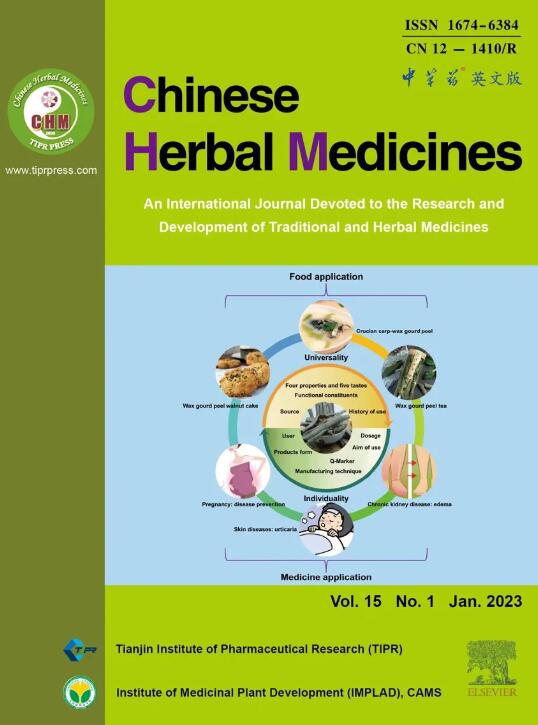Ecological factors impacting genetic characteristics and metabolite accumulations of Gastrodia elata
IF 4.7
4区 医学
Q1 CHEMISTRY, MEDICINAL
引用次数: 0
Abstract
Objective
The investigation of the correlation between ecological factors and the genetic characteristics or metabolites of plants offers valuable insights into the regional causes of genetic and metabolic diversity. Here, Gastrodia elata, a medicinal plant, is employed as a model to explore the environmental factors that influence its genetic characteristics and metabolic accumulations.
Methods
A total of 23 G. elata populations from six cultispecies and 11 cultivated regions were selected based on the predictions of the global geographic information system. The genetic characteristics of these populations were evaluated using highly polymorphic simple sequence repeat markers. Additionally, the metabolic accumulations and antioxidant capacity of mature tubers were measured employing colorimetry and high performance liquid chromatography (HPLC). Ecological data of each region were obtained from the WorldClim-global climate database and harmonized world soil database. To assess the influence of ecological factors on the genetic characteristics and metabolic profiles of G. elata, Pearson’s correlation analysis was conducted.
Results
Genetic variation among G. elata populations exceeded that within populations. Genetic diverisity, distance and structure manifested regional and species-specific patterns. Metabolic profiling and antioxidant capacity exhibited regional variations. Notably, the Lueyang region demonstrated that a content range of total polysaccharide, total protein, and phenolic glycosides was 9.34%−189.67% higher than the average. Similarly, in the Hubei region, total phenolic content, p-hydroxybenzyl alcohol content, and antioxidant indicators were observed to be higher than the average levels, by 106.57%, 136.47% and 12.50%−91.14%, respectively. Furthermore, ecological factors had a significant comprehensive impact on G. elata genetic characteristics (r > 0.256 and P < 0.05). Multivariate metabolite accumulations in G. elata were influenced by dominant ecological factors. Temperature notably impacted the accumulation of total protein (|r| > 0.528 and P < 0.05). Moisture, encompassing precipitation and soil content, significantly affected the production of phenolic glycosides (|r| > 0.503 and P < 0.05).
Conclusion
The genetic characteristics of G. elata manifested regional and species-specific patterns, with the metabolic accumulations and antioxidant capacity of mature tubers exhibited regional variations. Specifically, multivariate ecological factors comprehensively influenced genetic characteristics. Temperature and moisture played pivotal roles in regulating the accumulations of proteins and phenolic glycosides, respectively. These findings underscore the significant impact of ecological factors on the shaping of G. elata, highlighting their crucial role in enhancing the quality of Chinese medicinal materials.
影响天麻遗传特性和代谢物积累的生态因素
目的研究生态因子与植物遗传特征或代谢物的相关性,为植物遗传和代谢多样性的区域成因提供有价值的见解。本文以药用植物天麻为模型,探讨影响其遗传特性和代谢积累的环境因素。方法利用全球地理信息系统的预测数据,从6个栽培品种和11个栽培地区选取23个大叶黄居群。利用高度多态性的简单序列重复标记对这些群体的遗传特征进行了评价。此外,采用比色法和高效液相色谱法测定了成熟块茎的代谢积累和抗氧化能力。各区域生态数据来源于世界气候-全球气候数据库和世界土壤统一数据库。采用Pearson相关分析方法,评价生态因子对白桦遗传性状和代谢谱的影响。结果居群间遗传变异大于居群内遗传变异。遗传多样性、距离和结构表现出区域和物种特有的格局。代谢谱和抗氧化能力表现出区域差异。值得注意的是,吕阳地区的总多糖、总蛋白和酚类苷含量范围比平均水平高9.34% ~ 189.67%。湖北地区总酚含量、对羟基苯醇含量和抗氧化指标均高于平均水平,分别高出106.57%、136.47%和12.50% ~ 91.14%。此外,生态因子对白杨遗传特征有显著的综合影响(r >;0.256和P <;0.05)。白杨多变量代谢物积累受显性生态因子影响。温度显著影响总蛋白的积累(|r| >;0.528和P <;0.05)。水分,包括降水和土壤含量,显著影响酚类苷的生产(|或| >;0.503和P <;0.05)。结论龙舌兰遗传特征具有地域性和种特异性,成熟块茎代谢积累和抗氧化能力具有地域性差异。具体来说,多元生态因素综合影响遗传特征。温度和湿度分别在调节蛋白质和酚苷的积累中起关键作用。这些研究结果强调了生态因子对龙葵形成的显著影响,强调了它们在提高中药材质量方面的重要作用。
本文章由计算机程序翻译,如有差异,请以英文原文为准。
求助全文
约1分钟内获得全文
求助全文
来源期刊

Chinese Herbal Medicines
CHEMISTRY, MEDICINAL-
CiteScore
4.40
自引率
5.30%
发文量
629
审稿时长
10 weeks
期刊介绍:
Chinese Herbal Medicines is intended to disseminate the latest developments and research progress in traditional and herbal medical sciences to researchers, practitioners, academics and administrators worldwide in the field of traditional and herbal medicines. The journal's international coverage ensures that research and progress from all regions of the world are widely included.
CHM is a core journal of Chinese science and technology. The journal entered into the ESCI database in 2017, and then was included in PMC, Scopus and other important international search systems. In 2019, CHM was successfully selected for the “China Science and Technology Journal Excellence Action Plan” project, which has markedly improved its international influence and industry popularity. CHM obtained the first impact factor of 3.8 in Journal Citation Reports (JCR) in 2023.
 求助内容:
求助内容: 应助结果提醒方式:
应助结果提醒方式:


